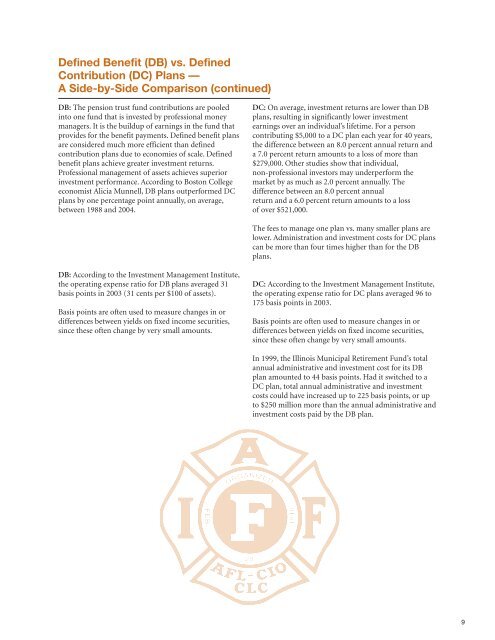Pension Handbook - International Association of Fire Fighters
Pension Handbook - International Association of Fire Fighters
Pension Handbook - International Association of Fire Fighters
Create successful ePaper yourself
Turn your PDF publications into a flip-book with our unique Google optimized e-Paper software.
Defined Benefit (DB) vs. Defined<br />
Contribution (DC) Plans —<br />
A Side-by-Side Comparison (continued)<br />
DB: The pension trust fund contributions are pooled<br />
into one fund that is invested by pr<strong>of</strong>essional money<br />
managers. It is the buildup <strong>of</strong> earnings in the fund that<br />
provides for the benefit payments. Defined benefit plans<br />
are considered much more efficient than defined<br />
contribution plans due to economies <strong>of</strong> scale. Defined<br />
benefit plans achieve greater investment returns.<br />
Pr<strong>of</strong>essional management <strong>of</strong> assets achieves superior<br />
investment performance. According to Boston College<br />
economist Alicia Munnell, DB plans outperformed DC<br />
plans by one percentage point annually, on average,<br />
between 1988 and 2004.<br />
DC: On average, investment returns are lower than DB<br />
plans, resulting in significantly lower investment<br />
earnings over an individual’s lifetime. For a person<br />
contributing $5,000 to a DC plan each year for 40 years,<br />
the difference between an 8.0 percent annual return and<br />
a 7.0 percent return amounts to a loss <strong>of</strong> more than<br />
$279,000. Other studies show that individual,<br />
non-pr<strong>of</strong>essional investors may underperform the<br />
market by as much as 2.0 percent annually. The<br />
difference between an 8.0 percent annual<br />
return and a 6.0 percent return amounts to a loss<br />
<strong>of</strong> over $521,000.<br />
The fees to manage one plan vs. many smaller plans are<br />
lower. Administration and investment costs for DC plans<br />
can be more than four times higher than for the DB<br />
plans.<br />
DB: According to the Investment Management Institute,<br />
the operating expense ratio for DB plans averaged 31<br />
basis points in 2003 (31 cents per $100 <strong>of</strong> assets).<br />
Basis points are <strong>of</strong>ten used to measure changes in or<br />
differences between yields on fixed income securities,<br />
since these <strong>of</strong>ten change by very small amounts.<br />
DC: According to the Investment Management Institute,<br />
the operating expense ratio for DC plans averaged 96 to<br />
175 basis points in 2003.<br />
Basis points are <strong>of</strong>ten used to measure changes in or<br />
differences between yields on fixed income securities,<br />
since these <strong>of</strong>ten change by very small amounts.<br />
In 1999, the Illinois Municipal Retirement Fund’s total<br />
annual administrative and investment cost for its DB<br />
plan amounted to 44 basis points. Had it switched to a<br />
DC plan, total annual administrative and investment<br />
costs could have increased up to 225 basis points, or up<br />
to $250 million more than the annual administrative and<br />
investment costs paid by the DB plan.<br />
9

















